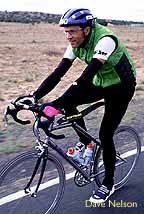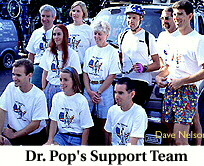Dr. Pop’s Race Across America (1996)
by Patricia Kirk
Brotman Medical Center
Listening to Dr. Peter Pop’s account of his experiences in the Race Across America (RAAM), one has to wonder if a proton beam could have richocheted off something in his lab and hit him in the head. Short of a medical accident, what could have possessed this gentle and apparently sensible radiologist from Brotman Medical Center, to get on a bicycle in Irvine and peddle like a madman in the searing August heat, to Savannah, Georgia, for the sport of it? Carpe diem! Known as the longest, cruelest bicycle race in the world, RAAM’s course ensures only the fittest will survive, taking its participants the long way around, over the roughest terrain, to the appointed destination. Established by Cyclist John Marino in 1982, RAAM takes a different transcontinental course each year. This year, the race took cyclists on a 2,905-mile trek across the sizzling Mojave, up 10,000-foot mountains in Colorado, through torrential thunderstorms in the Heartland, to the mosquito infested swamplands of the South. Says Pop, "If you’re into long-distance cycling, RAAM is the ultimate challenge. There’s nothing tougher."Twenty-three men and three women, between the ages of 28 and 49, took part in Solo RAAM, which began on August 1. Fourteen finished, only 11 officially. To finish officially, a cyclist must arrive at the destination within 48 hours of the winner. Winner Danny Chew made it in eight days, 7 hours and 14 minutes. Pop, 47, a RAAM rookie, made it to Savannah 46 hours after Chew. As the last to officially finish, he received the $350 Red Lantern award. Laughing, Pop notes that the race, which personally cost him $14,000 in expenses, offers a total of few thousand dollars in small cash and merchandise prizes. "The prize is to finish," he says, noting that only 106 cyclists have officially finished the race since its inception.
Pop began bicycling for exercise three years ago, after hurting his back horseback riding. He started out taking 20- to 30-mile rides to stay in shape and progressed to competitions of 100 and then 200 miles. His first big race was the Furnace 508, a 510-mile race from Magic Mountain through Death Valley to 29 Palms. Pop made that run in 30 hours and 20 minutes, distinguishing himself as the fastest rookie. He began training for RAAM six months before the race. "I rode 300 to 400 miles a week. That is about all I have time for with work and family responsibilities," Pop says, noting that cyclists who win RAAM ride about 800 miles a week. While on call for the hospital, he had to stay near a phone, so he used this time training on CompuTrainer, a stationary bike linked to a computer, with software that creates a training experience.
 Peter Pop-----Peter's Crew
Peter Pop-----Peter's Crew
So what was it like on Pop’s tour of
America, which took him across California and northern Arizona
through Prescott, Williams and Flagstaff to picturesque Durango,
Colorado, up the 10,857-foot climb through Wolf Creek Pass, then
south into Oklahoma, Arkansas and Tennessee and on to Georgia.
"It’s whoever gets there first, so you’re peddling
a bike as fast as you can 22 hours a day, stopping to sleep for
just two hours. All you see on the way is pavement and an amazing
array of road-kill," he says. Getting across the desert was
the most grueling part of the trip, notes Pop, and the end of it
for some of the cyclists. "Usually, there’s a tailwind
into Palm Springs. But the day we left, there was a terrific
headwind going up the Chiriaco Grade." With the daytime
temperature at 110 to 115 degrees, dehydration was the biggest
danger for the first 600 to 700 miles of the trip, he says.
"I drank lots of Energy Surge (a liquid
nutrition produce manufactured by E-CAPS) and ate plenty of salt
to have a good electrolyte balance. My crew, which followed me in
a van, used a weed sprayer to create a mist of cold water to cool
me down." Not everyone came through that leg of journey
unscathed. Several cyclists went to hospitals for dehydration
between Palms Springs and Blythe and were put on IVs for a few
hours before getting back on the road. Others got wiped out
totally by the desert, 500 to 1000 miles into the race, he adds.
Climbing the three mountain passes in Colorado
was a piece of cake for Pop, who trained for the race on the
mountain ranges nearby his home in Malibu. His major fears
throughout the trip were falling asleep on the bike and loose
dogs. Suffering from saddle sores and sleep deprivation, Pop says
that encountering stray dogs, especially some really vicious ones
on the Navajo Reservation, added some scary moments to his trip.
A crew of nine, which included his wife Linda, kept Pop awake
playing loud rock music on a PA system mounted on top of the van.
A motor home, which followed the van, allowed members of the crew
to sleep in shifts, ensuring several people would always be
rested and available to help Pop stay awake, fed and safe. Pop
took along five bicycles, adjusted and equipped for the various
geographical situations he would encounter. He only ended up
using three of them: one with lightweight wheels set-up for
climbing, and the other two equipped for the flats, with a
Softride beam and Softride handlebar stem to ease the impact of
road bumps on the rider’s seat and arms. RAAM rules are very
strict to ensure no one has an advantage. "You’re not
allowed to’draft’ other riders, place the van in front
of a rider to break headwinds, nor are crew members allowed to
run alongside and encourage you on when the going gets
tough," he continues. "It’s a race against the
clock, and every minute lost hurts in the end," Pop says,
noting that he didn’t even stop to eat. Nevertheless, Chew
had a one-day lead over Pop within the first 1,200 miles of the
race. "We lost a lot of time just because none of us had any
experience at this," he says. A couple of hours were lost
when the pain from saddle bruises became too severe for Pop to
continue. Fortunately from then on copious amounts of Chamois Buttr' healed Penguin's
sore behind (editors note) And, of course,
there were some less serious moments lost. "I stopped to go
to the bathroom in the middle of the night, and one of my crew
members stepped out of the motor home onto a live snake. It
wasn’t poisonous, but it was a surprise. We lost 15 minutes
standing there looking at that snake and talking about it,"
Pop recalls. 
All things considered, Pop made good time,
averaging about 18 m.p.h on the road; with stops figured in for
sleeping, bike adjustments, repairs and all, about 12. m.p.h. And
he came through it without too much lasting physical damage.
"If you train properly, bicycling isn’t detrimental to
your health, unless, of course, you crash. I did hold the
handlebars way too tight and developed a weakness in my fingers,
something I’m trying to improve with exercise." Eating
14,000 calories a day, mostly derived from Energy Surge, Pop also managed
to gain two pounds of pure muscle. "High-speed cycling burns
about 700 calories per hour. The supply of calories has to be
constant, otherwise, you will experience "bonking," a
term used to describe difficulty pushing the pedals," he
explains, "because of lack of glycogen in muscles."
Liquid nutrition is the primary food source for long-distance
cyclists, because it is both convenient and converted into energy
much quicker than solids.
"RAAM is a race against nature, the
toughest ride you can take. All along, I had this feeling that I
had to get to the coast. I’m glad I did it. I learned
something about myself. After 2,000 miles, days of sleep
deprivation and pain, I was able to wake up after two hours of
sleep, feeling disoriented„not sure who I was, where I was
or why I was there„and get back on that bike and continue
on. Having survived this ordeal, I feel that I somehow emerged a
better person. But still there is still the feeling that I could
have done better. And next year I will."
